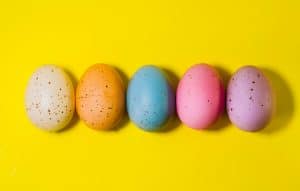We know many KneeBouncers love our various Shape Games, so we thought we’d share a fun way to extend shape learning: tangrams!
Playing with shapes introduces your child to the different names of shapes and how they are formed. For example, a triangle has three sides. This type of thinking develops mathematical concepts and is early geometry; yes, even preschoolers learn geometry. We just don’t call it that!
Tangrams are a type of puzzle, and puzzle-building blocks, LEGOs, and other building toys are all examples of preschool geometry!

While you may not have appreciated geometry class when you were 16, all geometry is simply understanding spatial perception and how we organize spatial relationships. I often joke that baggers at grocery stores should have to practice with tangrams because I don’t get how or why they put things in the bags the way they do!
Early geometry skills are critical for young minds, but there is no need to run out and get a textbook or flash cards. Play-based activities like shape scavenger hunts, drawing shapes on paper, and pointing out different shapes you see in your environment will set a great foundation.

What are Tangrams?
Tangrams are a traditional Chinese puzzle made of a square divided into seven pieces: one parallelogram, one square, and five triangles. This set of shapes can then be arranged to match particular designs. They are also a fun way to encourage your child to develop shape identification, geometry skills, and creativity.
Tangrams are easy to make on your own. Create shapes and cut out different-colored pieces of construction paper, cardstock, or heavier-weight scrap paper you have lying around. They are also inexpensive to buy from most retailers.

Now, all you have to do is sit down with your child and identify the different shapes.
Together, work to create new shapes and objects (real or imagined!) out of the tangram pieces. Here are a few questions you may want to ask your child:
- How could you make a rectangle?
- How could you make a square with the triangles?
- Can you make an animal out of the shapes? What animal? Which shapes do you need?
- Can you make a monster out of the shapes? What is your monster’s name? Why did you pick that name?
- How could you build a house out of the shapes? Who lives in that house? What shapes did you use to build the house?
The best part? Just have fun. This activity is all about creating and using imagination, with a bit of math on the side, of course!
Updated August 31, 2024, by L. Elizabeth Forry








